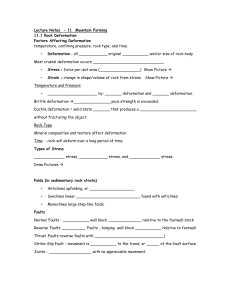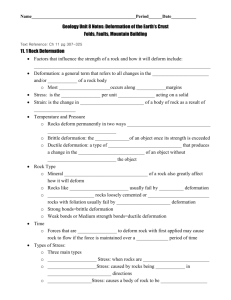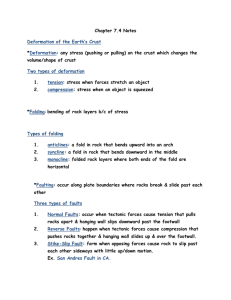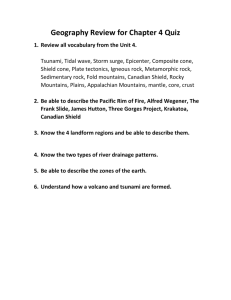Chapter 11 Mountain Building 11.1 Rock Deformation Factors
advertisement
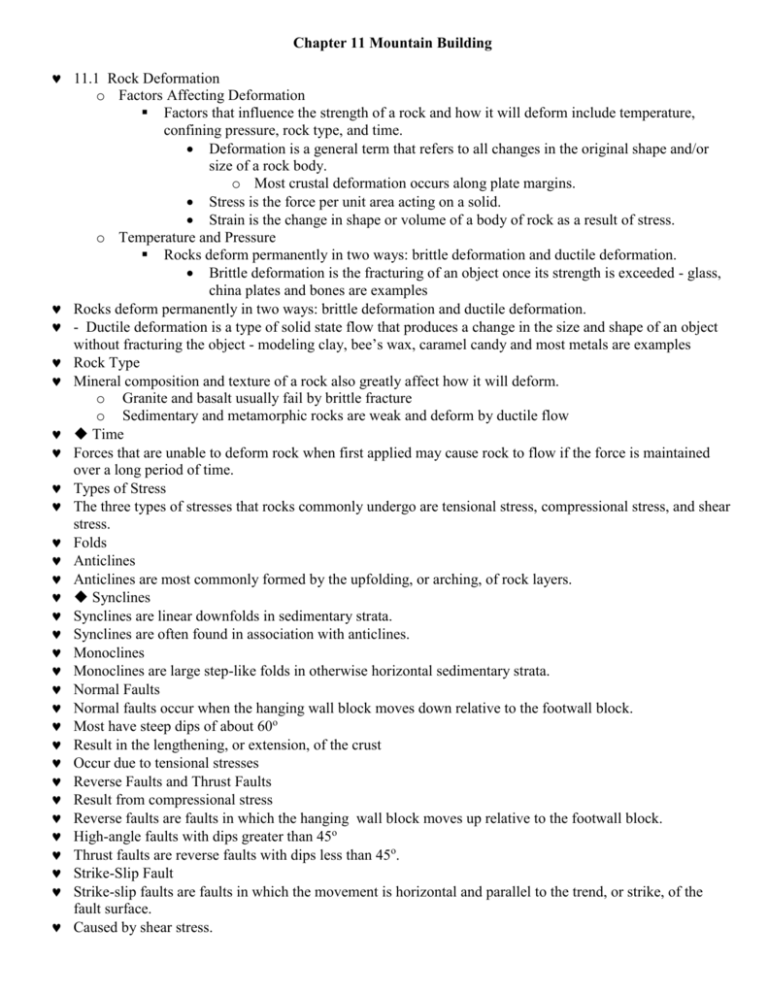
Chapter 11 Mountain Building 11.1 Rock Deformation o Factors Affecting Deformation Factors that influence the strength of a rock and how it will deform include temperature, confining pressure, rock type, and time. Deformation is a general term that refers to all changes in the original shape and/or size of a rock body. o Most crustal deformation occurs along plate margins. Stress is the force per unit area acting on a solid. Strain is the change in shape or volume of a body of rock as a result of stress. o Temperature and Pressure Rocks deform permanently in two ways: brittle deformation and ductile deformation. Brittle deformation is the fracturing of an object once its strength is exceeded - glass, china plates and bones are examples Rocks deform permanently in two ways: brittle deformation and ductile deformation. - Ductile deformation is a type of solid state flow that produces a change in the size and shape of an object without fracturing the object - modeling clay, bee’s wax, caramel candy and most metals are examples Rock Type Mineral composition and texture of a rock also greatly affect how it will deform. o Granite and basalt usually fail by brittle fracture o Sedimentary and metamorphic rocks are weak and deform by ductile flow Time Forces that are unable to deform rock when first applied may cause rock to flow if the force is maintained over a long period of time. Types of Stress The three types of stresses that rocks commonly undergo are tensional stress, compressional stress, and shear stress. Folds Anticlines Anticlines are most commonly formed by the upfolding, or arching, of rock layers. Synclines Synclines are linear downfolds in sedimentary strata. Synclines are often found in association with anticlines. Monoclines Monoclines are large step-like folds in otherwise horizontal sedimentary strata. Normal Faults Normal faults occur when the hanging wall block moves down relative to the footwall block. Most have steep dips of about 60o Result in the lengthening, or extension, of the crust Occur due to tensional stresses Reverse Faults and Thrust Faults Result from compressional stress Reverse faults are faults in which the hanging wall block moves up relative to the footwall block. High-angle faults with dips greater than 45o Thrust faults are reverse faults with dips less than 45o. Strike-Slip Fault Strike-slip faults are faults in which the movement is horizontal and parallel to the trend, or strike, of the fault surface. Caused by shear stress. Joints Joints are fractures along which no appreciable movement has occurred. The result of large-scale regional stresses. 11.2 Types of Mountains Folded Mountains Mountains are classified by the dominant processes that have formed them. Orogenesis is the collection of processes that result in the forming of mountains. Mountains that are formed primarily by folding are called folded mountains. A folded mountain is caused by extreme force pushing from both sides of the plates. This great pressure causes mountain to break, bend, and fold Fault-Block Mountains Large-scale normal faults are associated with structures called fault-block mountains. Fault-block mountains are formed as large blocks of crust are uplifted and tilted along normal faults. Grabens (ditch or trench) are formed by the downward displacement of fault-bounded blocks. Horsts are elongated, uplifted blocks of crust bounded by faults. A block fault mountain is created when a mountain rises from the earth. When the mountain rises pressure causes the rock to crack and slide. This creates sharp and distinctive faces on the mountain. Domes and Basins When upwarping produces a circular or elongated structure, the feature is called a dome. Uplifted mountains are circular or elongated structures formed by uplifting of the underlying basement rock. A dome mountain is formed when melted rock is pushed up through the earth's crust without folding or faulting creating a dome like shape of the mountain Erosion is believed to be a major factor in the shaping of most dome formations. Volcanic Mountains A volcanic mountain is formed when melted rock rises from the earth and builds up over time on the earth’s surface. This is how Mount St. Helens was formed. 11.3 Mountain Formation Mountain Building at Convergent Boundaries Most mountain building occurs at convergent plate boundaries. Colliding plates provide the compressional forces that fold, fault, and metamorphose the thick layers of sediments deposited at the edges of landmasses. Ocean-Ocean Convergence Ocean-ocean convergence mainly produces volcanic mountains. Ocean-Continental Convergence The types of mountains formed by ocean-continental convergence are volcanic mountains and folded mountains. An accretionary wedge is the accumulation of different sedimentary and metamorphic rocks with some scraps of ocean crust. Continental-Continental Convergence At a convergent boundary between two plates carrying continental crust, a collision between the continental fragments will result and form folded mountains. India and the Eurasian plate Mountain Building at Divergent Boundaries The mountains that form along ocean ridges at divergent plate boundaries are fault-block type mountains. o Mid-Atlantic Ridge Non-Boundary Mountains Not all mountains are formed by plate boundaries. Some are formed by hot spots or regional extension or stretching. Hawaiian Islands Continental Accretion Accretion is a process that occurs when crustal fragments collide with and stay connected to a continental plate. Many of the mountains along the Pacific Terranes Terranes are any crustal fragments that have a geologic history distinct from that of the adjoining fragments. Terranes occur along the Pacific Coast. Principles of Isostasy Isostatic Adjustment for Mountains Isostasy is the concept that Earth’s crust is floating in gravitational balance upon the material of the mantle. Because of isostasy, deformed and thickened crust will undergo regional uplift both during mountain building and for a long period afterward. Isostatic adjustment is the process of establishing a new level of gravitational equilibrium.

